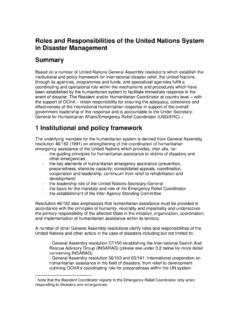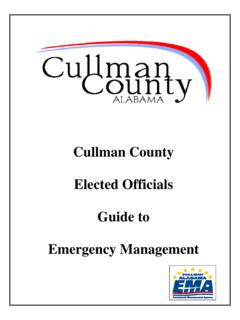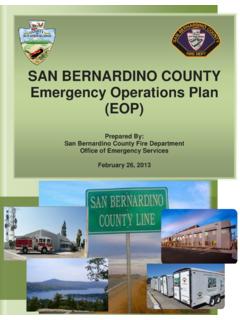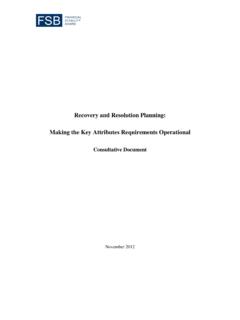Transcription of DCRS - Deloitte US
1 Peeling back the 2017 resolution planning guidance Summary of the 2017 section 165(d) guidance for domestic covered companies that submitted resolution plans in July 2015 DCRSD eloitte Center forRegulatory StrategiesMay 2016 Deloitte recovery and resolution Planning (RRP) Center of ExcellenceIntroduction 3 Summary of 2017 Guidance 8 Capital 8 Liquidity 10 Governance 12 Operational 13 Payment.
2 Clearing and Settlement 13 Collateral 16 Management Information Systems 18 Shared and Outsourced Services 20 Legal Obstacles 21 Legal Entity Rationalization and Separability 22 Derivatives and Trading Activities 24 Public Section 26 Conclusion 27 Contacts 2931 Agencies Announce Determinations and Provide Feedback on resolution Plans of Eight Systemically Important, Domestic Banking Institutions (April 13, 2016), available at Guidance for 2017 165(d) Annual resolution Plan Submissions By Domestic Covered Companies that Submitted resolution Plans in July 2015, Federal Deposit Insurance Corporation and Board of Governors of the Federal Reserve System (April 13, 2016), available at 13, 2016 was a key milestone date for the evolution of resolution planning in the United States (US).
3 For the first time, the Federal Reserve Board (FRB) and the Federal Deposit Insurance Corporation (FDIC) (collectively, the agencies ) jointly determined that certain plans submitted by large banking organizations were not credible or would not facilitate an orderly resolution 1under the US Bankruptcy Code, a finding that requires the firms to revise their plans to demonstrate credibility. Institutions with resolution plans deemed not credible have until October 1, 2016 to address the identified , the agencies more clearly described the criteria for evaluating resolution plans and more transparently described the rationale for individual firm resolution plan determinations. For the first time, the agencies disclosed high-level components of their resolution Plan Assessment Framework used to evaluate and issue joint determinations on the 2015 resolution plans.
4 In addition, they publicly released redacted versions of the feedback letters submitted to individual institutions. This approach underscores the significance the agencies place on resolution planning and their belief in the public s right to know the degree of progress being made at systemically important institutions on ending too big to fail. Significantly, as part of the announcements, the agencies provided explicit guidance outlining expectations for the next full resolution plan submissions, which are due by July 1, This guidance further raises the bar and sets more specific standards that will affect all eight US global systemically important banks (G-SIBs) not just those found to have deficiencies in their 2015 resolution plan. Avoiding deficiency determinations in July 2017 will require firms to develop a fulsome understanding of gaps and action plans across the areas described by the new Takeaways from April 13 FRB and FDIC resolution Planning Announcement Regulators have significantly raised their expectations: Regulators believe firms have fallen short strategically and operationally at overcoming resolvability issues Quick turnaround time to address deficiencies: Five firms have until October 1, 2016 to address the identified deficiencies Next full resolution plan submissions due by July 1, 2017: The agencies are dropping the July 2016 full plan submission deadline.
5 All eight G-SIBs have a revised 2016 submission due by October 1, 2016. The scope of the required submission is tailored to the agencies resolution plan determination and firm-specific feedback letter The 2017 Guidance should not be overlooked: The 2017 Guidance highlights additional capabilities that are required by July 2017; firms should start determining their gaps and devise action plans to achieve the additional capabilities now required for an adequate plan and state of resolvability Increased transparency from agencies: The public documents identifying the criteria by which the agencies reviewed the plans and guidance on expectations for each of the critical areas coupled with the actual feedback letters to the banks have improved the transparency of the process. The guidance for the 2017 plan submissions further pressures banks to publicly demonstrate improvement4 resolution plan determinations of eight US G-SIBsFor a plan to be deemed not credible under Section 165(d) of the Dodd-Frank Wall Street Reform and Consumer Protection Act (Dodd-Frank Act), the FRB and the FDIC must jointly make a not credible determination.
6 Split votes may require remedial efforts but do not result in the more serious consequences of a unanimous determination. That should not be interpreted by an institution as needing to put less emphasis on remediation efforts. If an issue was identified by one or both of the agencies, the effort needs to be strong with a clear plan to agencies characterized the severity of their findings as deficiencies or shortcomings as follows: Deficiency: A weakness that individually or in conjunction with other aspects could undermine the feasibility of the firm s plan. Firms with jointly identified deficiencies were deemed to have not credible plans and must address the deficiencies by October 2016 Shortcoming: A weakness identified by the agencies that is not considered a deficiency, but raises questions about the feasibility of the plan. Identified shortcomings must be remediated by the next full plan submission in July 2017 The agencies jointly determined that the plans submitted by five G-SIBs were not credible or would not facilitate an orderly resolution under the Bankruptcy Code.
7 Further, for two other institutions, the agencies were split on whether any deficiencies existed, though both agencies identified shortcomings. One institution had no jointly identified deficiencies by either agency and avoided a not credible joint designation; however both agencies identified certain shortcomings with the underlying message is that all plans still have substantial work left, with some firms needing more work in certain areas than others. There was some relief provided, however; the agencies waived the July 2016 full plan submission deadline for the eight US G-SIBs, but required all firms to submit a status report on actions to address any deficiencies and shortcomings, as well as a public section that explains these actions at a high level, by October 1, 2016 (October 2016 submission). The scope of what is required in the October 2016 submission differs among institutions based on the agencies resolution plan determination and firm-specific feedback letter.
8 Section .5(c) of the agencies resolution plan rule outlines the requirements to resubmit a deficient resolution plan. Requirements under section .5(c) highlight that the institution must submit a revised resolution plan to the agencies that addresses deficiencies identified. Further expectations for the October 1, 2016 submission are outlined in each institution s feedback letter, and the agencies highlighted that the 2016 submission is not required to contain informational content other than what is as specified in the feedback letter. This limits the scope 2016 resolution Plan Submission Expectations:For plans with identified shortcomings and no deficiencies: Public section that explains planned actions to address the shortcomings Status report of actions to address shortcomingsFor plans with identified shortcomings and deficiencies: Public section that explains planned actions to address the shortcomings and actions taken to remediate deficiencies Status report of actions to address shortcomings Detailed explanation of revisions made by the institution to address the jointly identified deficiencies5of content in the 2016 submission to focus on the shortcomings and/or deficiencies the agencies jointly agree that an institution has not adequately remediated deficiencies, section.
9 6 of the resolution plan rule allows the agencies to impose additional prudential requirements ( , additional capital, leverage, or liquidity requirements) on the firm until it remediates the deficiencies. Upon imposing additional prudential requirements and if the firm has still failed to adequately remediate deficiencies, the FRB and FDIC, in consultation with the Financial Stability Oversight Council (FSOC), may require the firm to divest assets or operations after a two-year key is for institutions to demonstrate to the agencies that they are resolvable to avoid detrimental measures on the part of the agencies, such as increased capital or liquidity requirements as provided by the Dodd-Frank Act. Many of the deficiencies and shortfalls cannot be addressed fully in the timeframes provided given the complex nature of the issues that are involved. In these cases, detailed project plans need to be developed that include what can be achieved by the October 2016 and July 2017 dates along with specific milestones that can be used by both the institutions and the agencies to assess Feedback Letters:The FRB and FDIC provided each institution with specific feedback letters that detail the shortcomings and/or deficiencies of each firm s plan and provide specific remediation required of each firm; the letters range from nine to thirty same feedback letters with certain text redacted were released to the public as part of the announcement of resolution plan determinations.
10 The approach the agencies took to make public firm-specific feedback letters in redacted form has significantly expanded the type of information the agencies consider to be suitable for public consumption as it allows for differentiation of documented in the firm-specific feedback letters, the agencies identified shortcomings in all eight G-SIBs resolution plans, all of which require remediation TypeNumber of Institutions with FindingCapitalDeficiency1 Shortcoming-LiquidityDeficiency3 Shortcoming4 GovernanceDeficiency3 Shortcoming6 OperationalDeficiency3 Shortcoming3 Legal Entity RationalizationDeficiency4 Shortcoming1 Derivatives and tradingDeficiency1 Shortcoming46 The resolution plans submitted by each institution in July 2015 were the basis for the resolution plan determinations and assessments of shortcomings and deficiencies. However, following the July 2015 resolution plan submissions, institutions have continued to make progress on ex-ante projects which may relate to shortcomings and/or understand the impact of the regulatory findings and the additional capabilities that are required by the 2017 Guidance, institutions will need to assess their letters and understand what progress has been made to date and how it aligns with the expectations in the guidance.



















